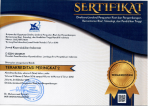Dilema petani di tengah dualisme kebijakan pertanian: Studi kasus strategi penghidupan berkelanjutan petani sawah di kawasan agropolitan Ciwidey, Jawa Barat
Abstract
Agriculture-based policies for rural development and food sufficiency lead to the welfare of farmers. However, the implementation of these policies often cannot address these issues. This study examines the impact of implementing agropolitan area and Sustainable Food Agricultural Land (LP2B) policies on paddy field farmers in the Ciwidey Agricultural Area. A review of the literature on regulations related to these two policies was conducted to identify their application in the Ciwidey area. Furthermore, a phenomenological qualitative approach was carried out to observe rice field farmers as the object of these policies. Agropolitan policies can create capital flows in agricultural areas that open opportunities to diverse farmers' livelihood portfolios. This capital inflow would be followed by activities of primitive accumulation that changed paddy field land tenure. In a strategic location, this change will increase the risk of the paddy field's conversion to non-agriculture. The LP2B policy is used to control this transfer of function. Unfortunately, the policy puts farmers with small land at risk of being in the survival strategy because their livelihood portfolio is limited. Their cultivated rice fields have less economic value compared to horticultural commodities. Although the LP2B policy can generally control land use conversion, paddy field farmers retain their identity. The primitive accumulation that follows the capital inflow due to agropolitan policy raises the risk of LP2B farmers become vulnerable in land ownership, changed from land owners to agricultural laborers. In general, this impact keeps the welfare of farmers below expectations.
Keywords
Full Text:
PDFReferences
Abramson, D. B. (2020). Ancient and current resilience in the Chengdu Plain: Agropolitan development re-‘revisited.’ Urban Studies, 57(7), 1372–1397. https://doi.org/10.1177/0042098019843020 Agustina, I., &
Artiningsih, A. (2017). Evaluasi implementasi masterplan kawasan agropolitan Ciwidey menggunakan logic models. Jurnal Wilayah dan Lingkungan, 5(1), 1-10. https://doi.org/10.14710/jwl.5.1.1-10
Amin, S. (2017). The agrarian question a century after October 1917: Capitalist agriculture and agricultures in capitalism. Agrarian South: Journal of Political Economy, 6(2), 149–174. https://doi.org/10.1177/2277976017731842
Bernstein, H. (2010). Class dynamics of agrarian change. Fernwood Pub.
Boomgard, P. (2004). Anak jajahan Belanda, sejarah sosial dan ekonomi Jawa 1795–1880.
Djambatan. Budiman, M. R., & Kurniasari, N. (2016). Kajian keterkaitan kegiatan ekonomi pertanian di Kawasan Agropolitan Ciwidey, Kabupaten Bandung. Prosiding Perencanaan Wilayah dan Kota, 2(2), http://dx.doi.org/10.29313/pwk.v0i0.4941
Chambers, R., & Conway, G. (1992). Sustainable rural livelihoods: Practical concepts for the 21st century. Institute of Development Studies.
Daris, E., Aminudin, I., & Feriansyah, A. (2017). Determinants of paddy fields conversion in Java Island, Indonesia. Proceedings of the International Conference on Science and Technology (ICOSAT 2017), 95–98. https://doi.org/10.2991/icosat-17.2018.22
Ellis, F. (1998). Household strategies and rural livelihood diversification. The Journal of Development Studies, 35(1), 1–38. https://doi.org/10.1080/00220389808422553
FAO. (2006, June). Food security. Policy Brief Issue 2, June 2006. https://www.fao.org/fileadmin/templates/faoitaly/documents/pdf/pdf_Food_Security_Cocept_Note.pdf FAO. (2022). FAO food price index. https://www.fao.org/worldfoodsituation/foodpricesindex/en/
Friedmann, J. (1985). Political and technical moments in development: Agropolitan development revisited. Environment and Planning D: Society and Space, 3(2), 155–167. https://doi.org/10.1068/d030155
Friedmann, J. R. P., & Douglass, M. (1978). Agropolitan development: Towards a new strategy for regional planning in Asia. Dalam P.C. Lo & K. Salih (Ed.), Growth Pole Strategy and Regional Development Policy (hlm. 163-192). Oxford Pergamon Press.
Friedmann, H., & McMichael, P. (1989). Agriculture and the state system: The rise and decline of national agricultures, 1870 to the present. Sociologia Ruralis, 29(2), 93–117. https://doi.org/10.1111/j.1467-9523.1989.tb00360.x
Gebru, K. M., Rammelt, C., Leung, M., Zoomers, A., & van Westen, G. (2021). The commodification of social relationships in agriculture: Evidence from northern Ethiopia. Geoforum, 126, 350-360. https://doi.org/10.1016/j.geoforum.2021.07.026
Harini, R., Ariani, R. D., Supriyati, S., & Satriagasa, M. C. (2019). Analisis luas lahan pertanian terhadap produksi padi di Kalimantan Utara. Jurnal Kawistara, 9(1), 15-27. https://doi.org/10.22146/kawistara.38755
Hidayat, R. A., Iskandar, J., Gunawan, B., &
Nurrokhmah Rizqihandari, Rijanta, Sudrajat, Rika Harini, Hafid Setiadi
Jurnal Kependudukan Indonesia Volume 17 No. 2 2022, hlm. 193–218
Partasasmita, R. (2020). Impact of green revolution on rice cultivation practices and production system: A case study in Sindang Hamlet, Rancakalong Village, Sumedang District, West Java, Indonesia. Biodiversitas Journal of Biological Diversity, 21(3), 1258-1265. https://doi.org/10.13057/biodiv/d210354
Headey, D. D., & Fan, S. (2010). Reflections on the global food crisis: How did it happen? How has it hurt? And how can we prevent the next one? International Food Policy Research Institute. https://doi.org/10.2499/9780896291782RM165
Iskandar, J., & Iskandar, B. S. (2011). Agroekosistem orang Sunda. Kiblat Buku Utama. Kasikoen, K. M., Fatmah, D. H., Yuni, R., Suryandari, & Suprajaka. (2020). Agropolitan and Regional Development in Indonesia: A Case Study of Langkaplancar District, West Java. International Journal of Society, Development, and Environment in the Developing World, 4(3), 60–73.
Komariah, Senge, M., Sumani, Dewi, W. S., Yoshiyama, K., & Rachmadiyanto, A. N. (2015). The impacts of decreasing paddy field area on local climate in Central Java, Indonesia. Air, Soil and Water Research, 8, ASWR.S21560. https://doi.org/10.4137/ASWR.S21560
Kurniawan, A. M., & Sudrajat. (2017) Diversifikasi pemanfaatan lahan sawah di Desa Tambakrejo Kecamatan Tempel Kabupaten Sleman Daerah Istimewa Yogyakarta. Jurnal Bumi Indonesia, 6(4). https://media.neliti.com/media/publications/228849-diversifikasi-pemanfaatan-lahan-sawah-di-4d99bb50.pdf
McDonald, B. L. (2017). The world food crisis and the end of the postwar food system. Dalam B. L. McDonald (Ed.), Food Power: The Rise and Fall of the Postwar American Food System. Oxford University Press. https://doi.org/10.1093/acprof:oso/9780190600686.003.0007
McMichael, P. (1997). Rethinking globalization: The agrarian question revisited. Review of International Political Economy, 4(4), 630–662. https://www.jstor.org/stable/4177246
Mulyani, A., Kuntjoro, D., Nursyamsi, D., & Agus, F. (2016). Konversi lahan sawah Indonesia sebagai ancaman terhadap ketahanan pangan. Jurnal Tanah dan Iklim, 40(2), 121-133. https://doi.org/10.21082/jti.v40n2.2016.121-133
Niehof, A. (2004). The significance of diversification for rural livelihood systems. Food Policy, 29(4), 321–338. https://doi.org/10.1016/j.foodpol.2004.07.009
Niehof, A. & Price, L. L. (2001). Rural livelihood systems: A conceptual framework. https://edepot.wur.nl/379081
Nurman, A., & Lund, C. (2016). On track: Spontaneous privatization of public urban land in Bandung, Indonesia. South East Asia Research, 24(1), 41–60. https://doi.org/10.5367/sear.2016.0296
Prasetiya, A., Suyadi, Bisri, M., & Soemarno. (2014). Analysis of Sendang Agropolitan Area development, Tulungagung. American Journal of Sociological Research, 4(2), 60–66. https://doi.org/10.5923/j.sociology.20140402.06
Purbiyanti, E., Yazid, M., & Januarti, I. (2017). Konversi lahan sawah di Indonesia dan pengaruhnya terhadap kebijakan Harga Pembelian Pemerintah (HPP) gabah/beras. Jurnal Manajemen & Agribisnis, 14(3), 209-217. https://doi.org/10.17358/jma.14.3.209
Ragil, C. (2017). Arahan pengembangan kawasan LP2B (Lahan Pertanian Pangan Berkelanjutan) padi berbasis D3TLH (Daya Dukung dan Daya
Tampung Lingkungan Hidup) di Kabupaten Kulon Progo. Prosiding Seminar Nasional XII Rekayasa Teknologi Industri dan Informasi 2017 Sekolah Tinggi Teknologi Nasional Yogyakarta.
Rosiadi, A., Juniarko, O., Putro, P. W., & Fatmawati, D. S. A. (2022). Can agropolitan promise prosperity and sustainability? The Journal of Indonesia Sustainable Development Planning, 3(1), 75-94. https://doi.org/10.46456/jisdep.v3i1.253
Sandy, I. M. (1977). Penggunaan tanah (land use) di Indonesia. Direktorat Tata Guna Tanah, Direktorat Jenderal Agraria, Departemen Dalam Negeri.
Scoones, I. (1998, 1 January). Sustainable rural livelihoods: A framework for analysis. IDS Working Paper 72. https://www.ids.ac.uk/publications/sustainable-rural-livelihoods-a-framework-for-analysis/
Scoones, I. (2015). Sustainable livelihoods and rural development. Practical Action Publishing. Soetomo, S. (2002). Dari urbanisasi ke morfologi kota: Mencari konsep pembangunan tata ruang kota yang beragam. Graha Ilmu.
Sumaryanto, Friyatno, S., & Irawan, B. (2001). Konversi lahan sawah ke penggunaan nonpertanian dan dampak negatifnya. Prosiding Seminar Nasional Multifungsi Lahan Sawah 2001 (hlm. 1-18). http://balittanah.litbang.pertanian.go.id/ind/dokumentasi/prosiding/mflp2001/sumaryanto.pdf
Surya, B., Saleh, H., Hamsina, H., Idris, M., & Ahmad, D. N. A. (2020). Rural agribusiness-based agropolitan area development and environmental management sustainability: Regional economic growth perspectives. International Journal of Energy Economics and Policy, 11(1), 142–157. https://www.econjournals.com/index.php/ijeep/article/view/10184
Syarifudin, D., & Ishak, R. F. (2020). The importance of rural social productive space to increase the social capital of agribusiness community in agropolitan area. Jurnal Wilayah Dan Lingkungan, 8(1), 67–83. https://doi.org/10.14710/jwl.8.1.67-83
Svensson, T. (1991). State bureaucracy and capitalism in rural West Java: Local gentry versus peasant entrepreneurs in Priangan in the 19th and 20th centuries. Nordic Institute of Asian Studies.
Taufik, M., Kurniawan, A., & Pusparini, F. M. (2017). Penentuan lahan pertanian pangan berkelanjutan (LP2B) menggunakan metode multi data spasial di Kecamatan Ngadirojo, Kabupaten Pacitan. Geoid, 13(1). https://doi.org/10.12962/j24423998.v13i1.3679
Verhoeven, J. T. A., & Setter, T. L. (2010). Agricultural use of wetlands: Opportunities and limitations. Annals of Botany, 105(1), 155–163. https://doi.org/10.1093/aob/mcp172
DOI: https://doi.org/10.14203/jki.v17i2.755
Copyright (c) 2022 Jurnal Kependudukan Indonesia

This work is licensed under a Creative Commons Attribution-NonCommercial-ShareAlike 4.0 International License.
-----------------------------------------------------------------------------------------------------------------------------
Research Center for Population, Indonesian Institute of Sciences
Widya Graha Building, 7th and 10th floors
Jl. Jenderal Gatot Subroto 10 Jakarta Selatan, Telp (021) 5221687
Website: http:/kependudukan.lipi.go.id;
E-Journal: http://ejurnal.kependudukan.lipi.go.id
Pustaka: http://pustaka.kependudukan.lipi.go.id
-----------------------------------------------------------------------------------------------------------------------------









